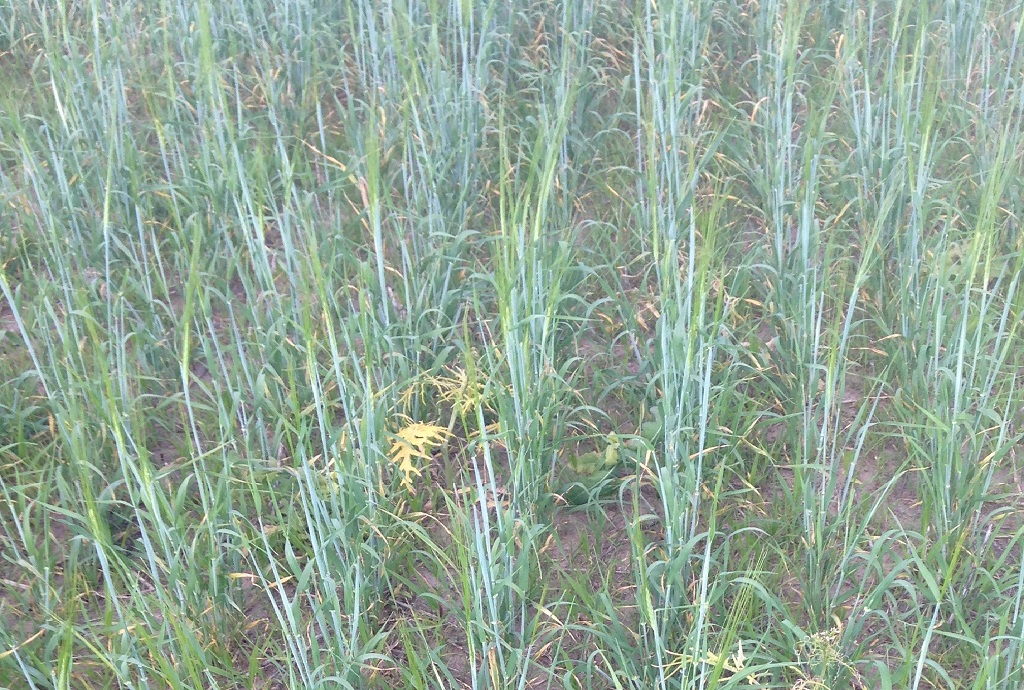By Jay Parsons

The Annual Forage Insurance Plan is available for two different seven month growing seasons. Photo courtesy of Jay Parsons.
The Rainfall Index – Annual Forage Insurance Plan is a new pilot insurance program from the USDA – Risk Management Agency (RMA). It was first offered in 2014 for the states of Nebraska, North Dakota, South Dakota, Kansas, Oklahoma, and Texas and has expanded to Colorado for 2016. The Annual Forage Insurance Plan is designed to meet the production risk management needs of producers planting annual forage crops for use as livestock feed or fodder. This includes but is not limited to grazing, haying, grazing/haying, grain/grazing, green chop, grazing/green chop, or silage.
Similar to Pasture, Rangeland and Forage insurance (PRF), the Annual Forage Insurance Plan is based off of rainfall index data provided by the National Oceanic and Atmospheric Administration Climate Prediction Center (NOAA CPC). With the Annual Forage Insurance Plan, producers are able to insure annual forage production value by dividing their liability across a series of two month intervals and insuring based on the Expected Grid Index representing the average precipitation data for the Grid ID. The grids are 0.25 degrees in latitude by 0.25 degrees in longitude. This translates to roughly 17 miles by 17 miles at the equator. Due to curvature of the earth, actual size will vary based on location. Each grid has an historic precipitation index calculated for it for each of the two month intervals dating back to 1948.
Both irrigated and non-irrigated acres are insurable. Each county in Nebraska has a County Base Value determined for it by RMA that represents its annual forage productive value regardless of production method. Producers choose to insure a percentage of this value by designating a productivity factor between 60% and 150%. This allows them to customize their coverage to fit their risk management needs. For example, the 2015 County Base Value for Buffalo County, Nebraska was $276.31 per acre so a Buffalo County producer could attach liability coverage between $165.79 per acre and $414.47 per acre depending upon their coverage needs and productivity factor selection.
The Annual Forage Insurance Plan is available for two different seven month growing seasons. The signup deadline for fall planted forage (planted between July 15 and November 15) is July 15 of each year for coverage available for a growing season from September 1 to March 31. The signup deadline for spring planted forage (planted between December 15 and July 15) is December 15 of each year for coverage available for a growing season from March 1 to September 30.
Producers can choose to allocate between 10% and 45% of their coverage protection to any one two-month interval without coverage overlap. For example, a Buffalo County producer with 100 acres of spring planted annual forage may choose to attach 20% of their coverage to the March-April interval, 40% of their coverage to the May-June interval, and 40% of their coverage to the July-August interval.
This insurance provides producers with the opportunity to insure up to 90% of the Expected Grid Index. If the current year precipitation index for an insured interval falls below the insured level, the producer purchasing the insurance may receive an indemnity payment based on the amount of the deficit and the dollar value insured. For example, suppose the May-June index for the above Buffalo County producer turns out to be 73 and the producer insured 100% of the County Base Value ($276.31) at the 90% coverage level with 40% of their coverage assigned to that interval. Then, the producer may receive an indemnity payment equal to their precipitation deficit times the County Base Value times their productivity factor of 100% times the 40% coverage level they assigned to that interval. In this case, that would amount to 17% x $276.31 x 40% equal to $18.79 per acre or $1,879 for the 100 acres insured.
Annual Forage Insurance Plan premium costs will vary depending upon the coverage selected. Producers interested in using the Plan are encouraged to access the decision support tool on the RMA website to explore various coverage options, premium costs and performance data based on historical rainfall indices. Premium costs are subsidized from 51% to 59% depending upon coverage level selection.
Catastrophic (CAT) coverage is also available in the Annual Forage Insurance Plan as long as the intended use is not to solely graze the insured acres. If the annual forage crop is planted with the intended use to hay, then graze, then CAT coverage is available for the crop. If circumstances develop that result in the crop only being grazed; that would still be permitted under CAT coverage. The key is the original intended use.
With CAT coverage, the producer does not pay a premium, but is required to pay an administrative fee of $300. Also, for CAT coverage, the coverage level is locked at 65% for one seven-month growing season interval and the productivity factor is locked at 45%.
Producers interested in using the Annual Forage Insurance Plan are encouraged to visit http://www.rma.usda.gov/policies/ri-vi/annualforage.html to access more information including a grid locator, decision support tool and all of the historical rainfall indices.
Source:unl.edu